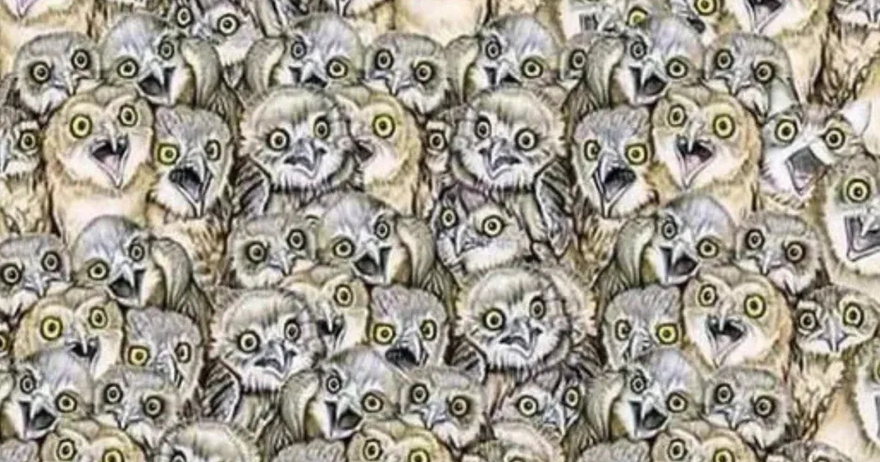The internet is buzzing with a brainteaser that has captured the attention of puzzle enthusiasts everywhere. A seemingly simple image of owls hides a clever twist: a single cat is lurking among them. While it sounds straightforward, this challenge has left many scratching their heads, trying to spot the sneaky feline. Are you up for the test?
Let’s dive into why this viral puzzle is so captivating, explore the science behind optical illusions, and, of course, help you uncover the elusive cat.
The Viral Owl and Cat Puzzle
At first glance, the image is nothing more than a grid filled with identical owls staring back at you. However, hidden in plain sight is a subtle detail—a cleverly camouflaged cat. The simplicity of the design is deceiving, and countless participants have found themselves stumped.
So, what’s the catch? The cat blends seamlessly with the owls, thanks to similar shapes and patterns, making it incredibly challenging to pick out. It’s a game of observation that requires both patience and a sharp eye.
Why Is This Puzzle So Difficult?
The difficulty of this puzzle lies in how our brains process visual information. When faced with repetitive patterns, our brains tend to focus on the overall image rather than its individual details. This tendency makes it easy to miss subtle differences, such as the cat’s unique features.
Additionally, our brains are wired to identify familiar patterns, which is why the owls dominate your attention. To find the cat, you need to shift your focus and actively look for what doesn’t belong—something that takes conscious effort.
How to Play: The 20-Second Challenge
Ready to test your skills? Here’s how to play:
-Look at the image filled with owls and try to find the cat hidden among them.
-Give yourself 20 seconds to spot the feline.
-If you can’t find it within the time limit, take a deep breath, reset your focus, and keep searching.
-The challenge is not just about speed but also about your ability to observe details and break away from predictable patterns.
The Big Reveal: Where Is the Cat?
Struggling to find it? Don’t worry, you’re not alone. The cat is hidden on the right side of the image, nestled among the owls in the third row from the top. If you look closely, you’ll notice subtle differences in the cat’s face, particularly its rounded features and smaller ears. Once you see it, you’ll wonder how you missed it!
The Science Behind Optical Illusions
Puzzles like this one work because they play with how our brains interpret visual stimuli. Optical illusions exploit the brain’s natural tendencies, making us perceive patterns, depth, or motion where none actually exist.
In this puzzle, the uniformity of the owls tricks the brain into seeing them as identical, even though one of them—the cat—is different. Recognizing the anomaly requires you to override your brain’s default mode of processing.
Benefits of Brain-Teasing Puzzles
Beyond the fun, puzzles like these offer numerous cognitive benefits:
Improved Observation Skills: They train your brain to notice details, a skill that’s useful in everyday life.
Enhanced Concentration: Focusing on finding the hidden element helps you sharpen your attention span.
Cognitive Stimulation: Regularly solving puzzles keeps your brain active, improving memory, problem-solving abilities, and overall mental agility.
Stress Relief: Taking a break to solve a puzzle can act as a mental reset, reducing stress and improving your mood.
Tips for Solving Visual Puzzles
Want to get better at puzzles like this? Here are some tips to hone your skills:
Scan Strategically: Start by scanning the image in sections rather than trying to take in the whole picture at once.
Focus on Differences: Train your eyes to look for irregularities instead of getting lost in the repetition.
Take Your Time: If you don’t see the answer immediately, step back, refocus, and try again.
Practice Regularly: The more puzzles you solve, the sharper your observation skills will become.
Why We Love Challenges Like This
There’s something inherently satisfying about solving a tricky puzzle. It taps into our natural desire to overcome challenges and test our abilities. Plus, puzzles like this one are a great way to engage with friends and family. Who can spot the cat first? Who has the sharpest eyes? These lighthearted competitions bring people together and spark fun conversations.
Social media also amplifies the appeal. Sharing your success—or commiserating over your struggles—turns a simple brainteaser into a communal experience.
The Social Appeal of Brainteasers
The owl and cat puzzle has gone viral not just because of its clever design but also because it’s easy to share. With a single image, you can challenge friends, start debates, and even spark friendly rivalries. The puzzle’s difficulty makes finding the cat a badge of honor, fueling its popularity.
Conclusion: Did You Spot the Cat?
Whether you found the cat in seconds or needed a little extra help, one thing’s for sure—this puzzle is a fantastic mental workout. It challenges your focus, sharpens your observation skills, and gives you a sense of accomplishment when you finally solve it.
So, the next time you come across a challenge like this, embrace it. Take your time, enjoy the process, and remember that puzzles are as much about the journey as they are about the solution. And if you’re feeling competitive, share this with your friends and see who can find the cat the fastest!
